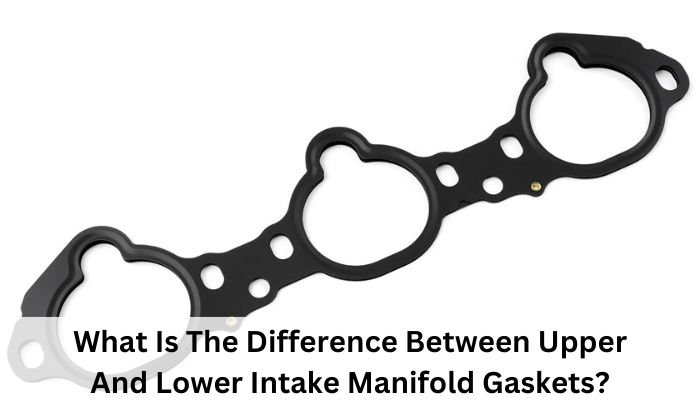Engine intake systems depend on intake manifold gaskets to seal crucial joints. Engine performance and dependability depend on understanding upper and lower intake manifold gaskets. Both gaskets prevent leaks, but their design, substance, and function vary.
This article compares upper and lower intake manifold gaskets, their effects on engine running, typical issues, maintenance, and replacement. Understanding these crucial components helps car owners and technicians maintain their cars and optimize engine performance.
| Difference | Description |
| Design and Location | Upper gaskets: between upper manifold and cylinder head. |
| Thickness and Material | Upper: thinner, rubber/silicone; Lower: thicker, robust. |
| Function and Pressure | Upper: seal air leaks, lower pressure; Lower: seal air and coolant leaks, higher pressure. |
| Installation and Accessibility | Upper gaskets are easier to access and install. |
| Impact on Engine Performance | Upper: lean mixtures, misfires; Lower: coolant leaks, overheating. |
What Are Upper Intake Manifold Gaskets?
Upper intake manifold gaskets seal the cylinder head-manifold junction. Rubber or silicone gaskets prevent air or coolant leakage. They’re essential to the combustion chamber’s air-fuel mixture. Upper intake manifold gaskets must withstand high temperatures and pressures. Due to their position, these gaskets are more straightforward to examine and replace than lower-intake manifold gaskets. Proper sealing and engine performance depend on high-quality gaskets.
What Are Lower Intake Manifold Gaskets?
Gaskets separate the engine block and lower intake manifold. They block air and coolant from escaping the intake system. These gaskets are usually rubber or silicone-like upper intake manifold gaskets. Due to increased pressures, they may be thicker and more robust. Lower intake manifold gaskets protect the intake system and optimize engine performance. These gaskets must be installed and maintained to avoid vacuum leaks and other performance difficulties.
Differences Between Upper And Lower Intake Manifold Gaskets
Design And Location:
Upper intake manifold gaskets seal the cylinder head-manifold gap. Lower intake manifold gaskets seal the engine block-manifold connection.
Thickness And Material:
Higher-intake manifold gaskets are thinner and more flexible. Rubber or silicone allows them to adhere to mating surface imperfections. However, lower-intake manifold gaskets are thicker and more robust to handle more significant pressures.
Function And Pressure:
Upper intake manifold gaskets prevent air leaks and ensure the right air-fuel combination enters the combustion chamber. They experience lower pressures than lower-intake manifold gaskets. Due to more significant cooling system pressures, lower intake manifold gaskets seal against air and coolant leaks.
Installation And Accessibility:
Upper intake manifold gaskets are more straightforward to examine and replace than lower intake ones due to their position. Upper intake manifold gaskets may be easier to install than lower ones, which may need more engine disassembly.
Impact On Engine Performance:
Upper and lower intake manifold gaskets are essential to engine efficiency, but their failure may cause various complications. Leaking upper intake manifold gaskets may cause low air-fuel mixes, engine misfires, and rough idling. However, faulty lower-intake manifold gaskets may cause coolant leaks, engine overheating, and oil contamination. Diagnosing and fixing engine issues requires understanding these variances.
How Do Upper And Lower Intake Manifold Gaskets Impact Engine Performance?
Engine performance depends on upper and lower intake manifold gaskets. These gaskets regulate engine airflow and coolant, altering combustion efficiency and performance. Upper intake manifold gaskets seal the cylinder head-upper intake manifold junction, affecting engine performance.
Leaks may inject air into the combustion chamber, creating a lean air-fuel combination. This may cause rough idling, engine hesitation, and power loss. A failed upper intake manifold gasket may also affect the engine’s vacuum levels, causing misfires and inconsistent performance.
However, lower intake manifold gaskets seal the engine block-manifold connection. These gaskets prevent coolant leaks and protect the engine’s cooling system. Coolant may seep into the combustion chamber or engine oil if a lower intake manifold gasket breaks. Coolant leaks may overheat the engine, damaging internal components and causing failure.
Upper and lower intake manifold gaskets affect engine performance and dependability. Proper gaskets guarantee the engine obtains the right air-fuel combination and runs at ideal temperatures. Gasket failure symptoms include coolant leaks, air leaks, and engine performance difficulties, and should be treated immediately to avoid additional damage and preserve engine efficiency. Intake manifold gaskets must be inspected regularly for smooth engine running and vehicle longevity.
Common Problems And Symptoms
Upper and lower intake manifold gasket failures generally indicate engine intake system troubles. Identifying these signs helps diagnose and resolve issues before they worsen. Common difficulties and symptoms to check for:
Air Leaks:
A leaky upper intake manifold gasket may add air to the combustion chamber, lowering the air-fuel combination. Rough idling, engine hesitation, and stalling, particularly during acceleration, are symptoms. A vacuum leak from a damaged gasket might also cause the check engine light and fuel trim DTCs.
Coolant Leaks:
Lower intake manifold gaskets often fail. A leaky lower intake manifold gasket may cause coolant puddles beneath the car, low reservoir coolant levels, or white exhaust smoke from coolant entering the combustion chamber.
Engine Overheating:
Coolant leaks produced by a malfunctioning lower intake manifold gasket may cause the engine to overheat. If the coolant level lowers or leaks, the engine may overheat. Drivers may notice a higher temperature gauge, steam from the engine compartment, or a limp mode to avoid damage.
Reduced Engine Performance:
Upper and lower intake manifold gasket failures might impair engine performance. A faulty gasket may disturb the air-fuel mixture entering the combustion chamber, reducing power, fuel economy, and acceleration. Drivers may notice engine power, response, or performance decline.
Coolant Contamination:
Coolant leaks from the lower intake manifold gasket and may contaminate the engine oil, making it milky. Contamination reduces oil’s lubrication, increasing friction and engine wear.
Misfires And Rough Running:
Air or coolant intake manifold gasket leaks may disturb engine combustion. Lack of power, rough idling, reluctance, or engine faltering under load are symptoms. In extreme circumstances, misfires may harm the catalytic converter and other emission control components.
Extreme Exhaust Emissions:
A defective intake manifold gasket may cause inefficient combustion and excessive exhaust emissions. Incorrect air-fuel ratios may cause incomplete combustion and increased HC, CO, and NOx emissions. This may compromise emissions tests and pollute the environment.
Recognizing these upper and lower intake manifold gasket flaws and symptoms helps diagnose and fix them quickly. Periodic gasket inspection, maintenance, and replacement helps avoid engine damage and preserve vehicle reliability. For diagnosis and repair, call a trained technician if these symptoms occur.
Conclusion
Engine performance and dependability depend on understanding upper and lower intake manifold gaskets. Gaskets seal the intake system, preventing air and coolant leaks that damage engines. Automobile owners may avoid expensive repairs and prolong vehicle life by detecting gasket failure indicators and acting quickly.
FAQs
What Causes Intake Manifold Gasket Failure?
Age, heat cycles, and poor installation may damage intake manifold gaskets. Degradation of the gasket material might cause leaks. Coolant leaks and high engine temperatures promote gasket failure.
Can I Drive With A Leaking Intake Manifold Gasket?
Driving with a leaky intake manifold gasket is not advised. Leaking gaskets may harm engines, overheat them, and reduce performance. Repair or replacement must be done quickly to avoid engine damage.
How Often Should Intake Manifold Gaskets Be Replaced?
Driven typically, intake manifold gaskets last many years. However, they must be checked routinely for wear and damage. Driving behaviors, vehicle age, and environment affect replacement intervals.

